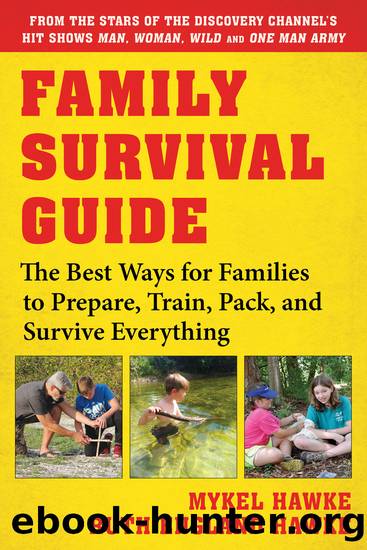Family Survival Guide: The Best Ways for Families to Prepare, Train, Pack, and Survive Everything by Mykel Hawke & Ruth England Hawke

Author:Mykel Hawke & Ruth England Hawke
Language: eng
Format: azw3
Tags: Social Science, Reference, Safety & Security, Nature, Disasters & Disaster Relief, Sports & Recreation, Natural Disasters, Outdoor Skills, Personal & Practical Guides, House & Home, Sustainable Living
ISBN: 9781510737952
Publisher: Simon and Schuster
Published: 2018-11-20T16:26:00+00:00
Maps: How to Read, Use, and Make Them
Making a pirateâs treasure map is a fun way to introduce younger children to the concept of navigation. First (as shown in the photo on the opposite page), brown the paper using coffee grounds and scrunch it up a bit before setting it out to dry. A hair dryer or the oven on a low level can help here if itâs not a sunny day. When ours was dry we burned the edges with a candle but you can just tear it up a bit to make it look worn. Then get drawing: make sure your little one draws a path that goes through one or two different terrain features and leads to an X, this way itâs definitely a map and not just an imaginative bit of artwork. (Photo credit Ruth England Hawke)
In-depth training for reading maps is beyond the scope of this book. But, if you have a map, use it. If not, consider making one. This is especially good for when you think you and your family are lost, or itâs just a great way to have your kids get familiar with the area.
Making your own map forces you and the kids to visualize your surroundings from a birdâs-eye view. Itâs a good exercise and can help you develop a better sense of awareness of the surroundings.
Making a map from scratch can also help you understand the terrain and its potential impact on you. Even if you are staying put, your homemade map might help you decide on a better place to make camp. And if youâre planning a move, itâs excellent help in planning a route.
Another great way to help kids visualize their area is by constructing a sand table. This is just making a model of the surrounding terrain in sand or dirt, using sticks as small trees and pebbles as rocks, or whatever else is available as a visual aid.
To make one, simply orient whatever you intend to write on toward the north and then build the map with your camp at the center. Add key terrain features and significant landmarks as you scout the area and discover new elements of your environment.
This is a really good exercise when you go camping and plan to stay put for a while. Once kids see the terrain like that, they just âget itâ and know where they are.
Another resource is software programs and other digital media like Google Earth®. You can show the kids on their own tablets or iPads exactly where there are and what is around them. You can widen out to show kids the rivers, hills, roads, and such around them while pointing those locales out in the real world.
Another great tool are apps like the SPOT Satellite Messenger and Rhino. SPOT has a lower cost version that just tells you where you are on another device or a higher end version that has a map you can see, too. The Rhino is a similar device that is a radio as well as a map.
Download
This site does not store any files on its server. We only index and link to content provided by other sites. Please contact the content providers to delete copyright contents if any and email us, we'll remove relevant links or contents immediately.
Man-made Catastrophes and Risk Information Concealment by Dmitry Chernov & Didier Sornette(4748)
The Revenge of Geography: What the Map Tells Us About Coming Conflicts and the Battle Against Fate by Kaplan Robert D(3602)
Zero Waste Home by Bea Johnson(3297)
COSMOS by Carl Sagan(2959)
In a Sunburned Country by Bill Bryson(2953)
Good by S. Walden(2920)
The Fate of Rome: Climate, Disease, and the End of an Empire (The Princeton History of the Ancient World) by Kyle Harper(2442)
Camino Island by John Grisham(2391)
A Wilder Time by William E. Glassley(2367)
Organic Mushroom Farming and Mycoremediation by Tradd Cotter(2313)
Human Dynamics Research in Smart and Connected Communities by Shih-Lung Shaw & Daniel Sui(2181)
The Ogre by Doug Scott(2119)
Energy Myths and Realities by Vaclav Smil(2066)
The Traveler's Gift by Andy Andrews(2017)
Inside the Middle East by Avi Melamed(1946)
Birds of New Guinea by Pratt Thane K.; Beehler Bruce M.; Anderton John C(1915)
Ultimate Navigation Manual by Lyle Brotherton(1770)
A History of Warfare by John Keegan(1722)
And the Band Played On by Randy Shilts(1620)
